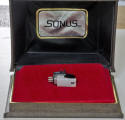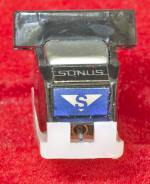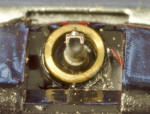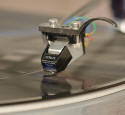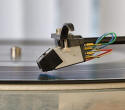-edible zone-
*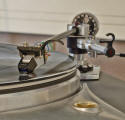 Listening on the Thorens TD124
Listening on the Thorens TD124
* Listening on the TD150 (R7 mods)
Listening on the TD150 (R7 mods)
Intro:
This is the second part of an investigation into
vintage phono cartridges to be paired with the Infinity Black Widow
tonearm. The primary qualifier in this search being that the cartridge
must have a very high compliance in order to match well with the very
low mass of the arm. The second qualifier being a reputation for
excellent sound qualities. There is nothing made today that will meet
the first requirement. The second requirement is not quite so hard but
you must use a different tonearm, which brings us back to the first
requirement. Anything I choose will be of a vintage 30 to 40 years past.
Fortunately it is still possible to find NOS cartridges up for sale.
This is the condition I look for.
The search
After
having experienced the Black Widow tonearm with the ADC XLM-II, (and
liking what I heard), I had further interest to see and hear if the
legendary Sonus Blue or Sonus Gold-Blue cartridges might have even
better sound than I'd heard with the ADC. So I went on a search for good
sample. These cartridges are rather scarce to find in working condition.
My first place to look was ebay. Some days it seems you can find
anything on ebay. I did find a scraggly assortment of Sonus cartridges
up for sale. Different labels. Most were used and with questionable
histories. Some were noted as being in need of a new stylus assembly.
(That would be a deal killer for me.)
I searched
elsewhere across the internet using Google as my search engine. (and
also Yahoo, DuckDuckGo) There is much anecdotal conversation about the
Sonus cartridges but not so much discussion about those in good
condition for sale. So back to ebay. I searched again and found one
seller that had a New Old Stock Sonus Blue in its case up for sale. The
price was kind of steep at $249.95. Not eager to part with so much for a
vintage MM I put it in my watch list at my ebay home page and continued
searching around the web. But no luck over a two week period. Afterward
I pulled the trigger, a Buy It Now price. The seller was "Merlin!!". His
after sale service was excellent. I bought it on a Saturday and took
delivery the following Saturday via 1st class mail.
Rationale
But why would I be looking at these vintage phono
cartridges at all? My meaning, already stated in the first article of
the series, is to take a look backward in time to sample those
components I missed having any experience with back in the days when I
might have. (I was focused on other stuff for quite some time.)
To add further motive I could say that having a hobby that plays Lp
records, a medium most of todays' humans have dismissed as being
hopelessly obsolete, is to look backward to the time when records were a
dominant medium for playing back recorded music. It only seems natural
that the equipment of those times might be just as vital now as they
were absolutely necessary then.
For the Black Widow tonearm, the
first cartridge I tried was a Peter Pritchard design, the ADC XLM-II.
The XLM-II is a high compliance "induced magnet" moving magnet
cartridge. I have reported it along with more of my motives for doing so
here. The second cartridge choice, the subject of this review, and also
by Pritchard, shares a design similarity with the ADC XLM series.
Induced magnet. Very high compliance. Similar omni-pivot suspension
arrangement. Internally it is very similar to the XLM. Externally, it
looks rather different.
Called the Sonus Blue it came into
existence after Pritchard had sold his ADC operation to the BSR
corporation. Afterward Pritchard, with further thinking on his induced
magnet design, started a new operation where he could continue his work
building phono cartridges. The new firm was called Sonic Research Corp.
Using the same generator body for several different cartridges within
the range he differentiated his new models by the color of the front
label and the stylus type. There was a Sonus Red label (bi-radial tip),
a Sonus Green label (spherical tip), a Sonus Blue label (Pathimax tip --
a Shibata variant) and lastly the Sonus Silver label (Pathimax or
elliptical tip) but the silver had a less compliant and rugged-ized
suspension for use on tonearms of normal effective mass. There was also
a Sonus Blue 'Calibrated' which were Sonus Blues that were hand selected
at the factory for having closer-to-nominal measurements. All of this
was circa 1976. Later on there was a Sonus Super Blue and a Sonus
Gold-Blue.
Don't use this cartridge, or any of its like, unless
you carry it with a very low effective mass tonearm. There are but a few
tonearms low enough in mass to make proper use of this extreme high
compliance cartridge. The Infinity Black Widow is one such tonearm at 3
grams effective mass. Another is the Mayware Formula IV (4grams
effective mass) or the Sonus Formula IV, Transcriptors Vestigal. Another
would be an SME III with exchangeable arm wands (rather than the
replaceable headshells of the earlier SME 3009 genre). Generally
speaking, the requirement here is for tonearms of less than 6-7 grams
effective mass. Mounting the Sonus Blue to heavier tonearms tends to
result in just average sound quality and early failure of the suspension
element within the cartridge. That is why you should not use a medium
mass or heavier tonearm with this cartridge. It is bad juju if you do.
The Setup: Listening on the Thorens TD124 and the Thorens TD150
At present there are two turntables within the listening room ready
to accept the Black Widow with Sonus Blue. A restored Thorens TD124 and
a restored Thorens TD150. Each being different from the other in drive
type. A third turntable, a Technics SP10 mkII is also standing nearby
but I have yet to cut an armboard that will be needed to mount the
Infinity tonearm to it. For now, the two Thorens will suffice to analyze
the essential qualities of this arm and cartridge pairing. The TD124,
having an idler driven platter, will offer greater energy at the platter
rim. The TD150, a polar opposite to the other, gets a mere 2 watts of
energy out of its synchronous AC motor to drive the platter assembly by
means of a very elastic belt. With the TD150, there is much less energy
at the platter rim to keep it in rotation.
Having listened to
the above two turntables with the Black Widow and ADC XLM-II it will be
possible to make direct listening comparisons between the ADC and The
Sonus Blue. A to B. Inquiring minds want to know.
- The owner's manual suggests a vertical tracking force of 1 to 1-1/2 grams. I set the tracking force at 1.2 grams.
- Overhang geometry is aligned per Stevenson with nulls at 60.325mm and 117.42mm. I used a TAD Arc protractor to adjust this important parameter. Note: had previously experimented with Lofgren A and Lofgren B. But the Stevenson resulted in a lesser offset angle - 21°
- Azimuth adjust is per mirror method. As mounted, the mirror indicates a perfectly aligned reflection. A decent starting point, but not absolute.
- Azimuth is adjustable out at the headshell of the BW tonearm.
- Vertical tracking Angle is listed as 20° nominal. The manual also indicates that the top mounting surface of the cartridge should be closely parallel to the record surface while at play. These are visual approximations used as an initial set point. Fine tuning of the VTA/SRA can be made by listening to familiar records I keep at hand and use for the purpose of adjusting VTA/SRA. The Black Widow tonearm is adjustable for VTA/SRA by means of a set screw at its base which is loosened enough to allow vertical adjustment of the tonearm base pillar position, then locked again.
- The BW tonearm in this review is equipped with a fluid damping trough with paddle. For the low compliant Sonus Blue, so far, I keep the trough empty. No motion dampening needed, I think. (editor's note: presently using a gear oil and it tracking is very good on this arm.
- Anti-skate on the BW is a magnetic design. I've set the slider to 1/2 grams of opposing force.
- Using the HFN001 test record, side 2 - track 2, I've measured tonearm/cartridge resonance at 9hz. This is within the optimal zone (8-12hz) and is at a frequency I sometimes tune other arms/cartridges to.
- The owner's manual suggests 400 pF max capacitance and 47K ohms of resistance. The original phono cables have been replaced with a modern din plug (female-Cardas) and wire (23ga ofc Canaire), from din plug to rca plugs has a measured capacitance of 70 pF left and right channels . The original internal wires (copper) within the tonearm are a 23 gage at the cartridge tags which splices into 33ga wire about the pivot and down to the din output. These are retained.
Stylus type: Pathimax. Pritchard describes this grind as a Shibata with more conical intersects between the ground faces. Stylus mounting is not nude. It appears bushed. In the photo, note the splatters of blue color on the tubular aluminum cantilever. Further identification that this is a "blue".
Listening listening room environment--
 -- (click on thumbnail to view image full size)
-- (click on thumbnail to view image full size)
It is noted above
that the cartridge came to me as NOS. (new old stock) Sometimes, when a
NOS product is purchased, the thing arrives dead. Other times one
questions the reason for the existence of this NOS item. Why was it not
sold back in its day? Was there an unreported defect? There is
definitely some risk associated. If dead, I'm out my $249.95 (plus $5.00
postage). At best it will be just like a new cartridge and simply
require the normal mounting and alignment procedure (noted above) and
then a normal break-in period where the suspension loosens up a little
while playing records. Not all cartridges require the same number of
hours to be fully broken in.
In an article posted by the Boston
Audio Society from 1976, there are notes from a speaking engagement
given by Peter Pritchard to that audio club. *(see footnotes) Among the
many points of he offered he did mention that the elastomer he used in
the suspensions of both his ADC and Sonus cartridges were of a material
impervious to atmospheric decay. Given this heartening information it
might be worth hoping that the NOS cartridge might be as good as the day
it was made. Lets hope.
To start, I had it on the TD124. The
first five hours it sounded like my memory of the ADC XLM-II.... only a
bit more constrained, less alive, less extended. But this impression
changed as the hours added up. After 5 hours of steady play it began to
sound much more alive and more extended. Quite worth the listen at this
point but not ready yet for any serious listening.
At 30 hours
the sound seems fully developed. Highs seeming to be well extended and
airy. The low frequency range gained authority as well as additional
detail. Midrange seems of a piece with the upper and lower ranges. A
good sense of aliveness, rich in texture and timbres with those records
that offer such. Attack transients seem very, very quick. Dynamic
capability is very great and capable of reproducing sudden and explosive
dynamic transients.
At 40 hours the sound seems much the same as
at 30 but with, perhaps, some subtle loosening up still. At this point
the entire range of reproduction seems fully developed and ready for
some close listening.
In case anyone wonders the RCA plugs
(Bullett - oxygen free copper ) plug into the RCA input of the Hagerman
Trumpet phono stage. At its input the Hagerman provides a 47K ohm
resistor. I've been using the Hagerman Trumpet for a couple of years now
and am familiar with its sound when processing the signals from a
variety of cartridges.
At this point I remounted the
tonearm/cartridge onto the TD150. I should note that while the TD150
does not offer the same amount of visceral thrust, there are some sonic
qualities of the TD150 I value. It has a sense of ease and
effortlessness. It gets the flow in a very natural manner while at the
same time offering quick transients, sudden dynamics.
On either
turntable, there is nothing at all relaxed or laid back about this
cartridge and tonearm combo.
Mercury SR90300. Byron Janis,
Prokofiev piano concerto No. 3, Rachmaninoff, piano concerto No. 1, ,
Kondrashin, Moscow Philharmonic. (matrix code: RFR-8 both sides)
performance / recording circa Spring 1962 on site in Moscow. Robert
Fine, Wilma Cozart, Harold Lawrence & Robert Ebernez on 35mm magnetic
film with their mobile recording studio in the van.
The
Prokofiev. The initial energy pulse of the flutes and piccolos, the
transients, have a very sharp attack. Fast. Loud. Suddenly very loud --
and just as suddenly - gone. Very short sustain. Fleeting. Attack is the
functional word here. Upon first exposure, it shocks the senses. Having
heard this record on occasion with different front end setups, I can say
that the speed of the transients rendered by the Sonus Blue/Black Widow
setup is on par if not perhaps even faster in comparison with the better
equipment I've heard it so far. Janis' piano strikes are also of the
sharp attack - short sustain type.... and these too are reported in a
clean articulation giving the sense of speedy delivery.
This
record is well known for its exceptional dynamic content. It is among
the most dynamic I've heard. That is why I choose to audition the Sonus
Blue with it. Overall there is no let down. This time It is still a
very, very dynamic experience to listen through the Prokofiev Concerto
No.3.
The weightiness of the piano is another issue altogether.
The Sonus Blue, does not provide as much ballsy body to that piano.
Partly due to the slam potential (or the lack there-of) of the turntable
and also differences between tonearms and cartridges in use.
Yet,
there is weight. Between the piano and orchestra there is bass, bass
with much low frequency detail. At one point one can easily identify
between the two instruments in the low octave piano strikes as the
double bass plays the same notes in unison. It is to experience a
pleasant addition of texture and timbre. Such stuff is entertaining and
provides some satisfaction for this listener.
Beethoven String
Quartets: Philips 6500 -180. Quartets No. 10 and no. 11. Quartetto
Italiano.
Numbers 10 & 11: played with emotion and flair. Tone is
well balanced between the three instrument types providing warmth of the
cello mid bass, soprano voice of the two violins and the alto of the
viola. As the playing gets louder the resonating belly of the cello
contributes woody body tones to mingle among the string tones. Never do
the violins sound strident or tipped up. Even when the volume is turned
up to "life-like" levels, tonality is comfortable to the ears. These
textured sounds seem well detailed.
Unlike the previously
auditioned Merc SR90300, this record does not provide lightening fast
transients or explosive dynamic. Rather, the initial energy pulse of
these notes has a touch of cushion to the beginnings, then a sense of
body and then trail-off one might sense as being natural to the style of
of the musicians. Another contrast between SR90300 and this string
quartet is that sense of body and weight; it seemed somewhat lacking on
the former is now entirely acceptable on the latter.
Cat
Stevens; Tea For The Tillerman. Analog Productions / QRP pressing 200g.
I chose this album for the Sonus Blue audition because of its
generous quantities of acoustic instrumentals which are rich with timbre
and texture. These are acoustic instruments amplified through an
attached microphone as on the double bass. A typical song structure on
this album is: intro - verse / chorus / repeat. The intros on these
songs tend to be just a few bars of guitar leading into the verse -- a
Stevens vocal lyric that tells a story. This part of it is sung with
delicacy and accompanied softly via guitar or violin and/or double bass.
When the song gets to the chorus there is a dynamic swing going loud
that has the dbl bass producing some genuine slam, drums may kick in as
the entire ensemble plus vocals fairly well rocks and rolls. The double
bass is notable throughout for the woody tones emanating from its belly
and through its F-holes. There is prominent string slap. This happens
time and again, song to song, throughout the entire album. I find it
tasty.
The Sonus Blue/BW managed the dynamic swings quite well,
producing satisfying amounts of slam and with speed and emotion. Vocals
and instrumentals are richly detailed. The double bass is well
reproduced for the timbre and texture I expected to hear. Satisfying.
Led Zeppelin II, Classic Records 180g.
For a hard rock title
I chose this album for its dynamic transitions from folk to full-on
bluesy rock. There is lots and lots of atmospheric spaces to be explored
within the sound fields created here.
To begin this is an album
that many readers are very familiar with and have known it much of their
lives -- as I have. However, as my system equipment list has evolved
over the years I can't help but notice just how much more I can see deep
into this album than back when I had bought it new in 1970. The first
track, side one, is Whole 'Lotta Love. At the drum solo, there is an
attempt a creating a psychedelic atmosphere on the part of the band.
While John Bonhams' drum kit cymbals ring and shimmer, hang and float to
the left and right , Page, with help from a mixing console and recording
engineer Eddie Kramer, creates wicked electronic sound effects, Plant
moans and screams as from a distance. There is a theramin added into the
wailing mix of it. My minds' eye imagines an alternate space. Almost but
not quite demonic in feel. Not a happy space, but not very scary. A
place with depth and volume for a surreal interlude. And, yes, I was
clear of mind while auditioning this piece for the review. What is
important to note here is that with the Sonus Blue/BW this bit was a
convincing illusion. Lesser gear would not have allowed such a vivid
recreation.
Throughout the album the Sonus Blue / BW allowed for
a stunning and highly atmospheric experience. Dynamic transitions were
quick and with slam. There was a great sense of atmosphere and space
throughout. I will say the the drum hits and bass, while well
articulated and fully extended and fleshed out in detail, did not have
the same level of force as I've heard the piece coming through other
tonearms and cartridges. The Shelter 501-II, for instance can present a
much more forceful delivery and a much greater sense of body and
solidity than does the subject of this review. However, If memory could
not reference this comparison, I might not miss it.
Conclusions
and summary:
At the onset I meant to make comparisons between the
Sonus Blue and the ADC XLM-II previously auditioned. The reason for this
is the similarity in design and perhaps a desire to decide if the Sonus
line of cartridges are really a continuation of Peter Pritchard's XLM
line from the days when he owned ADC.
My subjective impression
taken from listening I've done so far is that the ADC XLM-II and the
Sonus Blue when played from the same tonearm do in fact sound very
similar in overall character. They are from the same daddy. ;-) Yet, and
after listening for nearly 50 hours on each cartridge I can say that
while they have much in common, I think the Sonus Blue is allowing a
little bit more atmosphere, a little more texture, slightly more detail
than what I was getting with the ADC. ***
When auditioning the
full orchestral and hard rock records I noted above the comparison
between every moving magnet cartridge I've heard and every (low output)
moving coil cartridge I've heard. In that comparison the moving coil
cartridges (low output types) have all produced a much greater sense of
having greater body and solid musical presence. Meatier, is a term that
comes to mind. In this comparison the Sonus Blue and the ADC XLM-II are
alike in that they behave like other moving magnet designs producing a
lesser sense of body. But when there is not reference to a low output
moving coil cartridge in comparison, nothing is missing.
When the
focus is on how much detail this cartridge reproduces in comparison to
the other moving coil types I have, I will say I've been pleasantly
surprised at just how good both the ADC and the Sonus Blue are at
musical detail retrieval. They don't miss much and the moving coils I've
had don't seem to have an advantage in this category.
I think
where I like the Sonus Blue best is in a near-field (close-in) listening
situation and listening to acoustic instrument pieces. String quartets,
jazz ensembles, folk music. Little girls playing guitars (Joni). These
are all rendered beautifully and to great listener satisfaction. It is
the larger more powerful recordings where I long for a rig that can make
a more ballsy presentation.
I like what this tonearm and
cartridge do for the TD150. It sounds faster and livelier, more dynamic
and expressive than with any previous tonearm and cartridge pairing I've
had on it to date. It may take up permanent residence on the little
Thorens. The TD124, I think , appreciates heavy tonearm carrying low
compliance moving coil cartridges. In that way it can do some serious
slam.
Other notes:
This cartridge, the Sonus
Blue, has a compliance rating of 50x10-6cm/Dyne. For the non-techies
among us that means a really,(really), softly sprung suspension. In
fact, there were very few tonearms with low enough effective mass to
correctly match up with this cartridge. But when the cartridge is
matched to an appropriate tonearm it will report an arm/cartridge
resonance within the happy range between 8 - 12 hz.
The Infinity
Black Widow tonearm used in this arm mates well with the Sonus Blue.
Together they measure an arm/cartridge resonance at 9 hz. (HFN 001 test
record - side 2, band 2) Nicely in the "happy zone". If all is well with
this cartridge, I should not experience any early suspension failures.
Time will tell.
The Sonus Blue, as well as the ADC XLM cartridges
in general have had a reputation for early and abrupt failures of its
highly compliant suspension. A typical failure would result in a
collapsed cantilever. There are various owner anecdotal accounts of this
happening under conditions that most audiophiles would consider normal
use for any other phono cartridge. It is not always clear that
suspension failures resulted by mishandling , effective mass mis-match
between arm and cartridge or thru other causes. Pritchard himself said
that it was not possible for the elastomer of the suspension lement to
suffer atmospheric degradation.** . He did note that there was a problem
with cantilever failures on previous ADC XLM models due to electrolytic
reaction between the different metals of the cantilever and armature. In
an 1976 article ** he said the following: "ADC ;had stylus assemblies
coming undone because the cantilever and armature were made of different
metals, and there was an electrolytic reaction between them. Sonus puts
a plastic barrier between cantilever and armature."
Sonus Blue
Specifications from user manual:
- Voltage Output 4.0 mV @ 5cm/sec
- Compliance: 50cms/dyne x 10-6
- Vertical Tracking Angle: 20° nominal
- channel balance ± 1dB
- Recommended load: 47k ohms
- Total Cartridge weight: 5.5 grams
- Tracking Force range: 1 to 1-1/2 grams
- Stylus Tip Form: Pathimax----(similar to Shibata but more conical at intersecting ground faces)
Alignments:
- Overhang per Stevenson
- inner null: 60.325
- outer null: 117.42
- offset angle: 21°
- Using one of my tad arc protractors
Footnotes:
*NOS: new old stock. Remaining from back in
the day, previously not having been used ,or if sealed seal must be
unbroken. In this instance the clamshell case that the cartridge was
sold in was not sealed...... but appearance of the cartridge indicates a
total lack of any previous use. A bit of lint and dust from having been
stored within its container, -otherwise fresh.
** Article.
w3/bostonaudiosociety.org/pdf/bass/BASS-04-08-7605b.pdf
***There
is a difference in stylus design. The XLM-II is listed as having a
"Diasa" elliptical tip. The Sonus Blue is listed as having a "Pathimax"
which the designer (Pritchard) says is a slightly modified Shibata
grind. Neither of these stylus types are nude mounted. But there is a
difference to be heard between two cartridges when the main difference
is in the grind geometry at the diamond stylus. Shibata tips are known
to retrieve excellent detail and greater amounts of it than will an
elliptical.
